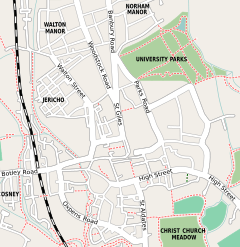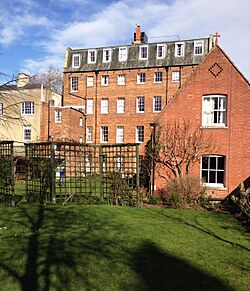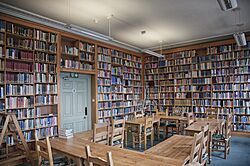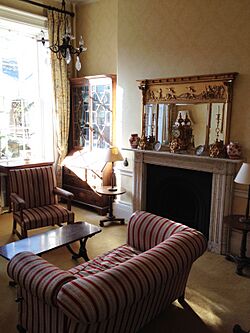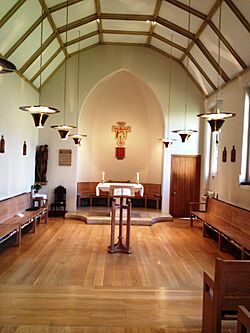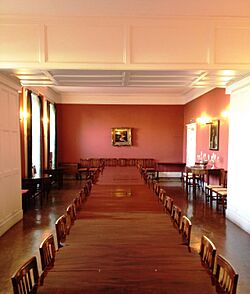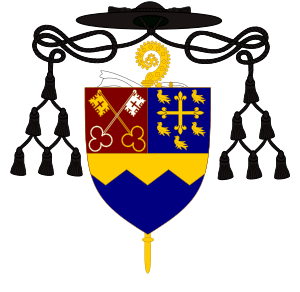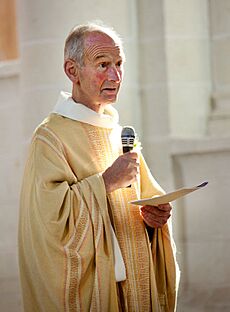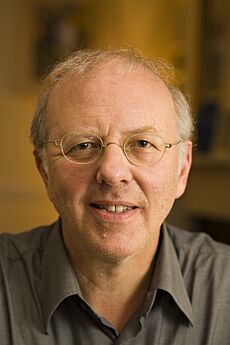St Benet's Hall, Oxford facts for kids
Quick facts for kids St Benet's Hall |
||||||||||||||||
|---|---|---|---|---|---|---|---|---|---|---|---|---|---|---|---|---|

Blazon: Per fesse dancetté or and azure, a chief per pale gules and of the second, charged on the dexter with two keys in saltire or and argent, and on the sinister with a cross flory between five martlets of the first.
|
||||||||||||||||
|
|
||||||||||||||||
| University | University of Oxford | |||||||||||||||
| Location | 38 St Giles', Oxford | |||||||||||||||
| Coordinates | 51°45′29″N 1°15′39″W / 51.757952°N 1.260787°W | |||||||||||||||
| Latin name | Aula Privata Sancti Benedicti | |||||||||||||||
| Motto | Ausculta, o fili, praecepta magistri | |||||||||||||||
| Motto in English | Listen, O child, to the master's precepts | |||||||||||||||
| Established | 1897 | |||||||||||||||
| Closed | 2022 | |||||||||||||||
| Named after | St Benedict of Nursia | |||||||||||||||
| Boat club | St Benet's Hall Boat Club | |||||||||||||||
| Map | ||||||||||||||||
St Benet's Hall (also called Benet's) was a special type of college at the University of Oxford. It was known as a permanent private hall (PPH). It started as a place for Roman Catholic monks to study.
The hall closed in 2022. Its main building was located in Oxford, on a street called St Giles'. It was near the Woodstock Road.
Contents
History
Early Benedictine Students
Benedictine monks have studied at Oxford for a very long time. They were there as early as 1281. At that time, Gloucester Abbey started Gloucester College. The area now called Gloucester Green is named after this old college.
Later, in 1291, Durham Abbey founded Durham College. In 1362, Christ Church Priory from Canterbury started Canterbury College.
All three of these Benedictine colleges closed between 1536 and 1545. This happened during the time when King Henry VIII closed many monasteries. Gloucester College later became Worcester College. Durham College became Trinity College. Canterbury College's land was taken over by Christ Church.
For over 350 years, Benedictine monks did not have a special place to study at Oxford. Then, St Benet's Hall opened in 1897.
How St Benet's Hall Began
St Benet's Hall was not a restart of any of the old Benedictine colleges. It was connected to Westminster Abbey through Ampleforth Abbey.
In the 960s, Saint Dunstan and King Edgar helped set up a group of Benedictine monks at Westminster. These monasteries were closed in England during the time of Henry VIII. However, Queen Mary I tried to bring Catholicism back in 1553 and reopened one monastery at Westminster Abbey. When Queen Elizabeth I became queen, she closed it again.
By 1607, only one of the Westminster monks, Sigebert Buckley, was still alive. In 1608, he passed on the "rights and privileges" of the old English Benedictine abbeys to two English monks who were living in Italy.
These two monks later joined a group in France in 1615. They lived in an old church near Nancy. In 1792, they had to leave France because of the French Revolution. They decided to return to England.
One Benedictine priest, Father Anselm Bolton, helped them. He gave them a house called Ampleforth Lodge in North Yorkshire. In 1802, the monks from France moved into this house. It became their new monastery, Ampleforth Priory. In 1803, the monks started Ampleforth College, which is now a Catholic secondary school.
Ampleforth Priory became an independent abbey in 1899. In 1918, Ampleforth Abbey renamed its Oxford study hall "St Benet's Hall." It then became a permanent private hall of the university.
A Private Hall for Students
In October 1897, Ampleforth Priory opened a study hall in Oxford. This was so its monks could earn degrees from the University of Oxford. It wasn't just for theology; monks could study any subject.
These private halls were often named after their Master. So, St Benet's was first called Hunter-Blair's Hall, then Parker's Hall. It started at 103 Woodstock Road. This building is still there today as a guest-house.
The hall moved several times. In 1904, it moved to Beaumont Street. Then, in 1922, it moved to its final buildings at 38 and 39 St Giles. The Beaumont Street houses were later taken down to build the Oxford Playhouse theatre.
Becoming a Permanent Private Hall
St Benet's officially became a permanent private hall (PPH) of the university in 1918. This was after new university rules created the PPH status. Its official Latin name was Aula Privata Sancti Benedicti. In English, this means "St Benedict's Private Hall." "Benet" is an old English way of saying "Benedict."
The hall was named after St Benedict of Nursia (around 480–547 AD). He founded the Benedictine order and is seen as a patron saint of Europe and students.
Over time, the hall changed. It started to have fellows, like other Oxford colleges. These fellows helped run the hall day-to-day. Students who joined St Benet's were full members of the university. The main difference was that St Benet's was much smaller than other Oxford colleges.
As fewer people became monks after the 1960s, St Benet's started to accept more non-monk students, called laymen. At first, it focused more on theology. But later, it welcomed students studying many subjects like theology, philosophy, and humanities.
There was no rule that students had to be Catholic. In the 21st century, most students were not. However, everyone was asked to respect the monks' way of life.
In 2007, the university reviewed St Benet's. They said it had a "good sense of its place" and praised the "commitment and care" of its staff. In 2013, a student survey showed St Benet's Hall had the highest student satisfaction score among all Oxford colleges and halls.
The Final Years
Until 2012, the Master of St Benet's was always a Benedictine monk from Ampleforth. On September 1, 2012, Werner Jeanrond became the new Master. He was the first non-monk (layman) to lead the hall. He also taught at Oxford.
Until 2016, St Benet's was the last part of Oxford University that only accepted men. St Hilda's College, the last all-women's college, started accepting men in 2008. In November 2013, St Benet's announced it would admit women graduate students within a year. It would admit women undergraduate students once it had more housing.
Women graduate students joined in October 2014. Women undergraduate students joined in October 2016. This meant that by 2016, all Oxford colleges and halls became mixed-gender.
To make space for women undergraduates, St Benet's Hall bought a new building in October 2015. It was at 11 Norham Gardens. So, the hall became a mixed-gender community. It had 84 undergraduate students and 48 graduate students of all faiths.
The last undergraduate students at St Benet's studied subjects like Theology, History, Philosophy, and Classics. Graduate students studied these subjects and others like Government and Business.
Closure of the Hall
In September 2021, a rich foundation offered £40 million to help St Benet's Hall become fully independent from Ampleforth Abbey. This offer had conditions, like buying the buildings for £15 million and making the St Benet's Trust completely separate.
However, in December 2021, the university said it was worried. Without the abbey's money, they weren't sure the hall could support new students for their full studies. The hall didn't have enough money saved, and the abbey owned the buildings and covered the hall's running costs.
So, the university decided to temporarily stop St Benet's from accepting new undergraduate students. A final decision was due in May 2022.
In May, the university announced it would not renew the hall's licence. This meant St Benet's Hall would close at the end of the 2022 academic year. The university felt the new plans were not financially strong enough.
In June 2022, it was confirmed that the buildings would be empty by October 2022. The university helped existing students move to other colleges. The buildings were later bought by St Hilda's College. St Benet's Hall officially closed on September 30, 2022. Students moved to other colleges to finish their studies. The St Benet's Hall Boat Club still continues to operate.
St Benet's Hall Association
The St Benet’s Hall Association is a group started in 2007 by former students of Benet's. Its goal is to keep people who studied, lived, or taught at St Benet’s Hall connected. After the hall closed, this association became the main way for former students around the world to stay in touch. They organize social events and networking meetings.
Former Buildings
38 and 39 St Giles
The hall was located at 38-39 St Giles from 1923 to 2022. It was a four-story building with an attic and cellars. It had a wrought iron balcony and six round-headed windows on the first floor.
The dining hall was on the ground floor. The common room and library were above it. The chapel was a separate building in the garden, made of red brick in a Gothic style.
The building was originally two separate houses, built in 1830. Before that, it was a fruit seller's yard and stable. In the 1800s, these houses were homes for university clergy and wealthy widows.
The northern house (38 St Giles) was home to important university figures like Philip Bliss and Richard Michell. It was also briefly the Oxford High School and the Oxford Eye Hospital. In 1891, it became St Ursula's Convent, a school for Catholic girls.
The southern house (39 St Giles) was also a private home for many years. It was owned by families like the Petts, Browns, and Greswells. The famous historian Charles Oman lived there too. In 1909, it was bought by the convent school next door. The chapel in the garden was part of the convent.
St Ursula's Convent School closed in 1922. Ampleforth Abbey bought both buildings in 1923 and joined them together for St Benet's Hall. It was the only building for the hall until 2015.
11 Norham Gardens
A large house at 11 Norham Gardens was bought in 2015. This was part of the hall's plan to grow.
This house was built in 1860. Famous people like Henry Balfour (first curator of the Pitt Rivers Museum) and Francis Llewellyn Griffith (first professor of Egyptology at Oxford) lived there.
In 1932, a Catholic group of nuns, the Society of the Sacred Heart, bought the house. They used it to house women students at Oxford. Later, a new wing was added in 1951, providing 21 rooms for students. By the 1990s, it housed only graduate students, both men and women. In 2015, the nuns sold the house to St Benet's Hall. This allowed St Benet's to become fully mixed-gender by 2016.
Administration
St Benet's Hall had a special "joint common room." This meant that all members of the hall – students, monks, and staff – were part of the same group. This group had its own committee. It was in charge of the hall's bar and gym.
Refectory
Unlike other Oxford colleges, St Benet's Hall did not have a "high table" where only senior members sat. Instead, everyone shared one common dining table. Students, fellows, monks, and their guests all ate together. The dining hall was called the refectory, which is a traditional name in monasteries.
Before formal meals, a prayer called a "grace" was said in Latin. This happened on Tuesdays, Thursdays, and Sundays. The Master or someone he chose would say the grace. After the grace, a student would read a short passage from the Rule of St Benedict in English.
The grace before the meal was:
-
- Gratiarum actio ante cibum
- Benedic Domine,
- nos et haec tua dona
- quae de tua largitate sumus sumpturi,
- per Christum Dominum nostrum. Amen
-
- Grace before the meal
- Bless us, O Lord,
- and these thy gifts
- which we are about to receive from thy bounty,
- through Christ our Lord. Amen.
After the meal, the chaplain would say a grace in Latin:
-
- Gratiarum actio post cibum
- Agimus tibi gratias,
- omnipotens Deus,
- pro universis beneficiis tuis,
- qui vivis et regnas in saecula saeculorum. Amen.
-
- Grace after the meal
- We give thee thanks,
- O almighty God,
- for all thy benefits,
- who livest and reignest for ever and ever. Amen.
Sport
Even though St Benet's Hall was small, its St Benet's Hall Boat Club had a rowing team. They raced an eight boat on the River Thames for many years. They were known for winning "blades." This is a trophy for rowing past every team ranked above them in races like Torpids and Summer Eights. The Boat Club's men's first team last won blades in 2019. Even though the hall is closed, the Boat Club still exists.
The hall also had its own teams for netball, rugby sevens, and field hockey. It had a football team with Regent's Park College. The Benet's rugby sevens team won the Oxford University rugby sevens championship in 2018 and 2019.
Coat of Arms
St Benet's Hall used the same coat of arms as Ampleforth Abbey and Ampleforth College. It did not include the abbot's special staff or hat. The College of Arms, which grants coats of arms in England, gave these arms to the abbey in 1922.
The coat of arms combines three different symbols:
- The top left part shows two keys on a red shield. This represents Saint Peter, to whom Westminster Abbey is dedicated.
- The top right part shows a gold "cross flory" (a cross with flowery ends) and five gold birds on a blue shield. This represents Edward the Confessor, an old English king and a patron saint of Westminster Abbey.
- The bottom part is gold and blue with a zigzag line. This represents the old Abbots of Westminster.
The full description of the arms is: Per fesse dancetté Or and Azure a chief per pale Gules and of the second charged on the dexter with two keys in saltire Or and Argent and on the sinister with a Cross Flory between five martlets of the first.
The hall's motto was Ausculta, O fili, praecepta magistri. This means "Listen, O [my] son, to the precepts of [thy] master." It comes from the first line of the Rule of St. Benedict.
People Associated with St Benet's
Masters
St Benet's had twelve Masters (leaders) since it started in 1897:
- Oswald Hunter Blair OSB (1898–1909)
- Anselm Parker OSB (1909–1920)
- Justin McCann OSB (1920–1947)
- Gerard Sitwell OSB (1947–1964)
- James Forbes OSB (1964–1979)
- Philip Holdsworth OSB (1979–1989)
- Fabian Cowper OSB (1989–1990)
- Henry Wansbrough OSB (1990–2004); Editor of the New Jerusalem Bible
- Leo Chamberlain OSB (2004–2007)
- Felix Stephens OSB (2007–2012)
- Werner Jeanrond (2012–2018)
- Richard Cooper (2018–2022)
Fellows
Some notable fellows (academic staff) of the hall included:
- Brian Klug, a senior researcher in Philosophy (2000–2022)
- Susan Doran, a fellow in history (2007–2022)
- Harry Sidebottom, a fellow and director of studies in ancient history (2008–2014)
Honorary Fellows
These are people given special recognition by the hall:
- Leo Chamberlain; Master of St Benet's Hall 2004–2007
- Peter Hennessy, Baron Hennessy of Nympsfield, a professor of British History
- Werner Jeanrond; Master of St Benet's Hall 2012–2018; a professor of Theology
- Henry Mayr-Harting; an emeritus professor of Ecclesiastical History
- Peter Sutherland, a lawyer and former Attorney General of Ireland
- Henry Wansbrough; Master of St Benet's Hall 1990–2004
Notable Alumni
Many people who studied at St Benet's Hall became well-known:
- John Balme, an American conductor and pianist
- David Blair, a chief foreign correspondent for the Daily Telegraph newspaper
- Bishop Donald Joseph Bolen, a Roman Catholic Bishop
- Damian Collins, a Member of Parliament (MP)
- John Cornwell, an author and academic
- Lumumba Stanislaus-Kaw Di-Aping, a Sudanese diplomat
- Cardinal Basil Hume (1923–1999), a former Abbot of Ampleforth and Archbishop of Westminster
- Professor Olegario González de Cardedal, a theology professor in Spain
- Martin Jennings, a sculptor
- Sir Anthony Kenny, a philosopher and former Master of Balliol College, Oxford
- General Jacko Page, a lieutenant general in the British Army
- Columba Stewart, an American Benedictine monk and scholar
|
See also
 In Spanish: Saint Benet's Hall para niños
In Spanish: Saint Benet's Hall para niños


